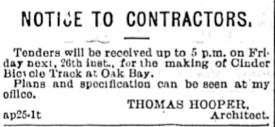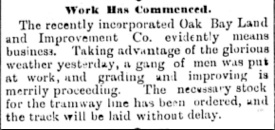Cycle Babble: Places



There were two major bicycle race tracks in Victoria during the 1890s, at Beacon Hill Park and Oak Bay Recreation Park (today's Windsor Park). Developments around these race tracks serve to support and extend Norcliffe's ideas that bicycle racing allowed Victorians to gain "big commercial advantages [by] winning races," and engage in a "forum for popular culture... which the movers and shakers in Canadian society attended in large numbers to enjoy one of the latest thrills.”(1) According to Norcliffe, Canada's changing sense of itself as a nation state was connected with bicycle racing. He notes that "in a small way the Cycle Racing Championships [at Montreal in August 1899] helped to build Canadian identity as an emerging modern state.”(2) Media coverage in Victoria supports this and similar claims that bicycle racing was related to nation building, a modernist construction.
Norcliffe connects the commercial advantages of racing only with manufacturers trying to prove that their bikes were fastest.(3) More importantly for creating new kinds of places in Victoria, bicycle race tracks became associated with commercial interests associated with real estate, construction and tourism. The Oak Bay Recreation Park was created by the Victoria Electric Railway and Lighting Company in 1895 to encourage use of the streetcar system.(4) Included in the park was a bicycle track, building on the popularity of cycle racing in the 1890s.
The race tracks at Beacon Hill and Oak Bay were also part of the popular culture of Victoria, drawing crowds of people to large events associated with the elite. For instance, there were bicycle races at Beacon Hill Park during the Victoria Day celebrations in May 1889, along with a number of other sporting events. Cricket, for instance, also brought out the elite in Victoria at that time.(7) Celebrating the Queen's birthday, in a colonial town named after her, was a significant event to be seen at and take part in. Similarly, towards the end of the decade, there was significant excitement about a midsummer cycle race at Oak Bay, with other sports advertised as happening at the same time.(8) These types of local, celebratory events were widely reported throughout the 1890s, and allowed crowds of people to enjoy the "popular culture" of these "thrills."
On a wider scale, as Canada started to create a sense of being an independent nation state, cycling events outside Victoria were reported in the press with a similar level of excitement. Canadian Wheelman's Association and International Cycling Association events were breathlessly reported locally in the Colonist throughout the 1890s. Norcliffe mentioned that the Cycle Racing Championships were reported widely across the country. Indeed, there were three days of front page coverage in the British Colonist that August, and on the fourth day it received second page coverage.(9) Prior to that, the results of an 1891 CWA race in Hamilton were reported in similar detail on the fifth page.(10) This indicates shrinking distances: local people were interested in cycling developments nationally and internationally, and were able to access information about it on a daily basis because of communications technology connected to modernism.
The bicycle track was built and paved by Thomas Hooper,(5) a famous British Columbian architect with connections to other powerful commercial interests. The V. E. R. L. Co. was itself connected with the Oak Bay Land & Improvement Company, having had some of its track laid by the real estate company.(6) Clearly, large economic interests were taking advantage of the bicycle craze in Victoria in the 1890s. These industries (the electric railway and real estate interests) are often associated with modernism, bringing electricity and organization to outlying municipalities.
Race Tracks
Copyright 2009. Vincent Gornall
“Notice to Contractors,” The Daily Coloinst, April 25, 1895, page 1, <http://www.britishcolonist.ca/display.php?issue=18950425>.
“Work Has Commenced,” The Daily Coloinst, April 1, 1891, page 5, <http://www.britishcolonist.ca/display.php?issue=18910401>.
"The Cyclists' Day," The Daily Colonist, July 10, 1897, page 8, <http://www.britishcolonist.ca/display.php?issue=18970710>.
“The Wheel,” The Daily Colonist, July 17, 1891, page 5, <http://www.britishcolonist.ca/display.php?issue=18910717>.









